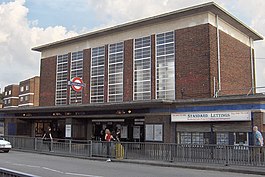| Acton Town | |
|---|---|
 Station entrance | |
| Location | Acton |
| Local authority | London Borough of Ealing |
| Managed by | London Underground |
| Number of platforms | 4 |
| Accessible | Yes[note 1] |
| Fare zone | 3 |
| London Underground annual entry and exit | |
| 2019 | |
| 2020 | |
| 2021 | |
| 2022 | |
| 2023 | |
| Railway companies | |
| Original company | District Railway |
| Key dates | |
| 1 July 1879 | Opened as Mill Hill Park on the line to Ealing Broadway |
| 1 March 1910 | Renamed Acton Town |
| 4 July 1932 | Piccadilly line services commenced |
| Listed status | |
| Listing grade | II |
| Entry number | 1263471[7] |
| Added to list | 17 May 1994[7] |
| Other information | |
| External links | |
| Coordinates | 51°30′10″N 0°16′48″W / 51.50278°N 0.28000°W |
Acton Town is a London Underground station in the south-west corner of Acton, West London, in the London Borough of Ealing, close to the border with the London Borough of Hounslow.[8] The station is served by the District and Piccadilly lines and is in Travelcard Zone 3.[9] On the District line, it is between Chiswick Park and Ealing Common stations, and on the Piccadilly line it is between Hammersmith (Turnham Green in the early mornings and late evenings) and Ealing Common on the Uxbridge branch & South Ealing on the Heathrow branch.[9] Acton Town station was opened as Mill Hill Park on 1 July 1879 by the District Railway (DR, now the District line).[10] It remained as a terminus until on 1 May 1883 and 23 June 1903 the DR opened two branches from Acton Town to Hounslow Town and Park Royal & Twyford Abbey respectively. On 4 July 1932 the Piccadilly line was extended to Acton Town. District line services to both the Hounslow and Uxbridge branches were withdrawn completely on 9 and 10 October 1964 after which operations were provided by the Piccadilly line alone.
The original brick-built station was built in 1879 and in February 1910 the station building was reconstructed.[10] On 1 March 1910 the station was given its present name.[10] In 1931 and 1932 the station was rebuilt again in preparation for transferring the Uxbridge branch service from the District line to the Piccadilly line.[10] The new station was designed by Charles Holden[10] in a modern European geometric style using brick, reinforced concrete and glass.[7]
- ^ "Avoiding stairs Tube guide" (PDF). Transport for London. May 2020. Archived from the original (PDF) on 27 November 2020.
- ^ "Station Usage Data" (XLSX). Usage Statistics for London Stations, 2019. Transport for London. 23 September 2020. Archived from the original on 9 November 2020. Retrieved 9 November 2020.
- ^ "Station Usage Data" (XLSX). Usage Statistics for London Stations, 2020. Transport for London. 16 April 2021. Retrieved 1 January 2022.
- ^ "Station Usage Data" (XLSX). Usage Statistics for London Stations, 2021. Transport for London. 12 July 2022. Retrieved 7 September 2022.
- ^ "Station Usage Data" (XLSX). Usage Statistics for London Stations, 2022. Transport for London. 4 October 2023. Retrieved 10 October 2023.
- ^ "Station Usage Data" (XLSX). Usage Statistics for London Stations, 2023. Transport for London. 8 August 2024. Retrieved 16 September 2024.
- ^ a b c Historic England. "Acton Town London Regional Transport Underground Station (1263471)". National Heritage List for England. Retrieved 23 August 2016.
- ^ "Initial Consultation on Possible Residents' Parking Schemes – Acton Town and Chiswick Main line station areas" (PDF). Hounslow Council. Archived from the original (PDF) on 23 June 2015. Retrieved 23 June 2015.
- ^ a b Standard Tube Map (PDF) (Map). Not to scale. Transport for London. April 2024. Archived (PDF) from the original on 28 May 2024. Retrieved 3 June 2024.
- ^ a b c d e Historic England. "Detailed Result:Acton Town Station (508142)". Research records (formerly PastScape). Retrieved 12 April 2015.
Cite error: There are <ref group=note> tags on this page, but the references will not show without a {{reflist|group=note}} template (see the help page).
